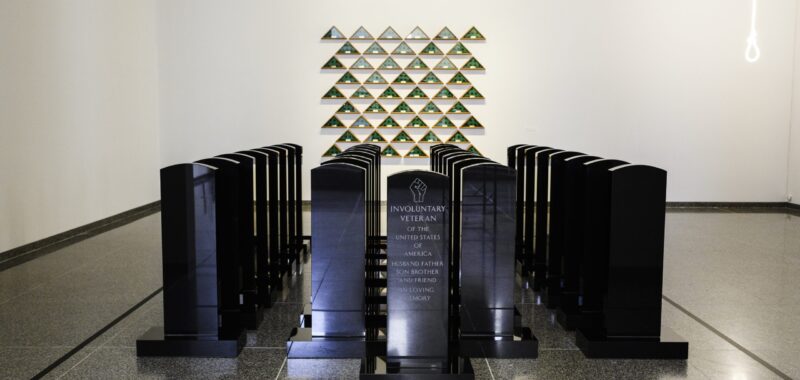DES MOINES, Iowa — Loss is intrinsic to the experience of being Black in America. This country’s centuries-long history of racial violence against Black people has resulted in a collective grief that binds all of us across generations. b. Robert Moore’s exhibition, In Loving Memory at the Des Moines Art Center, is one man’s artistic journey in contending with that ever-present grief. Through paintings, sculptures, and installations, Moore delves into ancestral trauma, laying bare the intimate and often heartbreaking realities of Blackness and anti-Blackness in the United States.
True to its title, the specter of Death hovers over the exhibition. In the first gallery, four black and white oval paintings hang like memorial portraits, evoking the 16th Street Baptist Church bombing that killed four little Black girls. In the main gallery, 34 black granite tombstones stand regally, like soldiers, making up the stunning centerpiece of the exhibition. The headstones are blank, except for one, which reads: “Involuntary Veteran of The United States of America, Husband Father Son Brother and Friend, In Loving Memory.” Mounted on the wall behind them is “Every N*gga a Star” (c. 2023) — a somber constellation of framed folded flags that recall those that typically commemorate fallen soldiers. Instead of the traditional stars and bars, however, Moore uses the red, black, and green African American flag, and the names engraved on the plaques are those of murdered Black Americans. Trayvon Martin, George Floyd, Breonna Taylor, Emmett Till, Eric Garner — the names go on and on. Walking into that gallery feels like attending a funeral.

At times the grief is almost too much to bear. Across the five or so galleries, the exhibition touches on themes like addiction, police brutality, lynchings, absentee parents, loss of family, labor inequities, and misogynoir, wringing out every ounce of feeling. A neon noose hangs from the ceiling in one corner, gleaming almost acidically. The painting “Kin to War” (c. 2023) depicts a doe-eyed Brown boy fastening on a military-grade helmet, a reminder that daily survival for Black people can feel like fighting in a war we are conscripted into from birth. Later, Moore takes us into his late grandmother’s sitting room in an ambitious installation cut directly from memory. With its plush brown carpet, family photos, and chintzy framed pictures of flowers, this could be the living room of any Black grandmother. The artist invites you to interact with the space: come in, sit down, and take a peppermint. Most poignantly, pick up the landline phone and you’ll hear audio of Moore’s late grandfather.
The exhibition vacillates between expressing collective Black grief and Afro-pessimism. Grief can be processed, and when channeled, can pave the way for healing; it can be forward-looking and optimistic. Afro-pessimism, on the other hand, is the belief that the Black experience is innately defined by violence, oppression, and anti-Blackness; it’s the perpetual tethering of Blackness to suffering. Moore is an undeniably talented artist. There’s plenty of beauty to be found in the pain on display in his work. But it’s not enough. Though a few works by other artists such as Njideka Akunyili Crosby and Arnaldo Roche-Rabell introduce other notes of emotion, Moore’s work doesn’t let up in pessimism. Blackness doesn’t need to be defined by the violence perpetrated against us, but nothing else is seen here. This show feels like standing next to an open grave.


b. Robert Moore: In Loving Memory continues at the Des Moines Art Center (4700 Grand Avenue, Des Moines, Iowa) through October 20. The exhibition was organized by Laura Burkhalter and b. Robert Moore.

